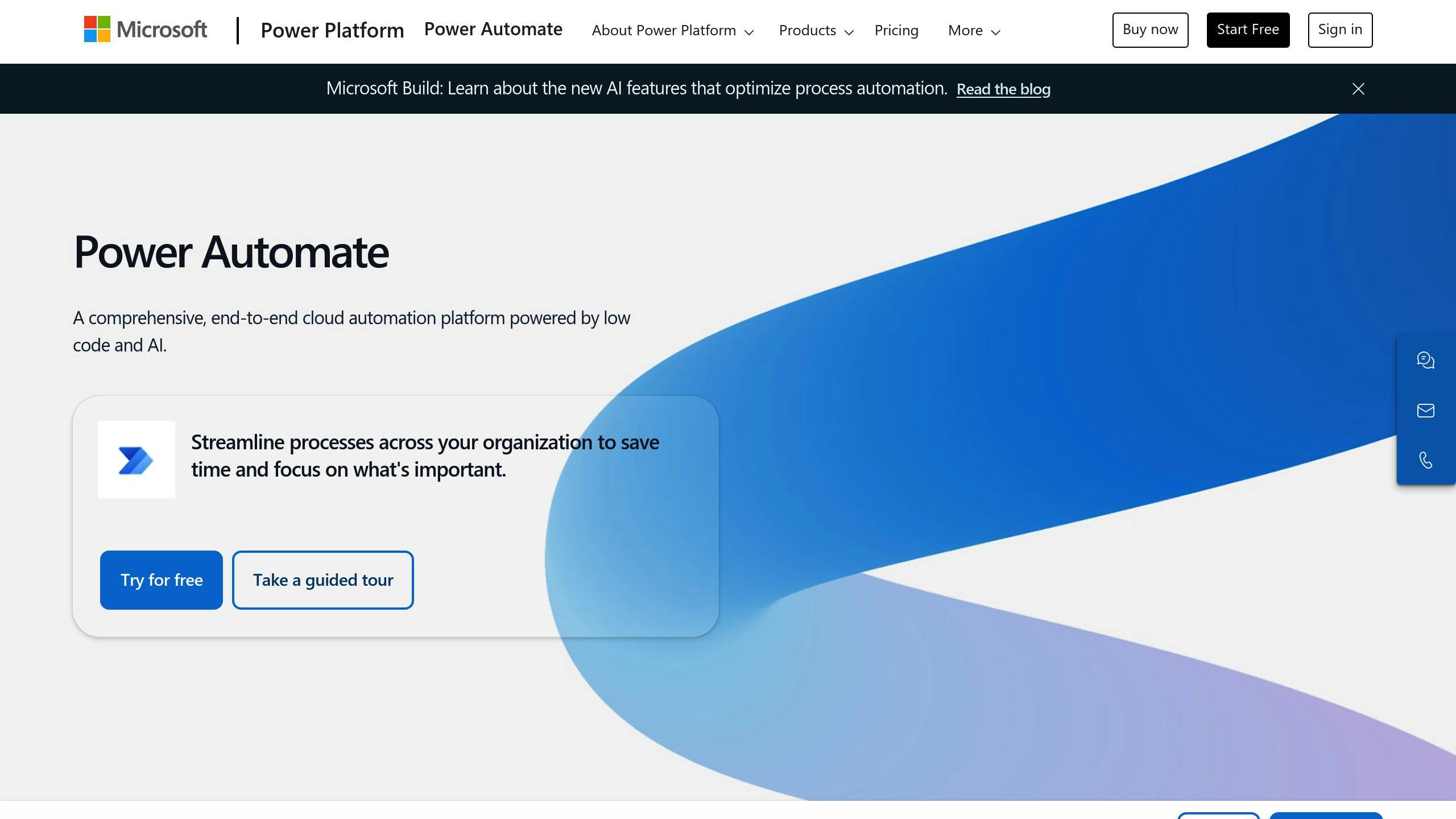Power Automate simplifies data transformation for businesses by automating workflows, reducing manual errors, and ensuring real-time data accuracy across platforms. Here’s what you need to know:
- Key Features: Prebuilt connectors, templates, data manipulation expressions (concat, split, substring), and AI Builder for unstructured data.
- Best Practices: Effective data mapping, governance, and error handling with tools like Select and Parse JSON actions.
- Integrations: Works seamlessly with Microsoft Teams and tools like nBold for standardized workflows and better collaboration.
- Benefits: Automates repetitive tasks, integrates custom business logic, and enhances data consistency across systems.
Power Automate is a low-code tool that enables businesses to streamline data processes without advanced coding skills, making it ideal for improving operational efficiency. Keep reading to learn how to leverage its features effectively.
Power Automate Data Operations: Compose, Join, Select, Filter, Create tables, Parse JSON

Key Features for Data Transformation in Power Automate
Power Automate makes handling and integrating data easier with tools designed to streamline workflows and simplify complex tasks.
Prebuilt Connectors and Templates
Prebuilt connectors help you link different data sources without needing to write code. For instance, the SharePoint connector allows you to retrieve and transform list data with ease [1][4]. Templates, such as ‘Copy files from SharePoint to OneDrive,’ automate repetitive tasks and ensure data accuracy, saving you time during setup [2][4].
Data Manipulation with Expressions
Expressions in Power Automate, like concat, split, and substring, allow for detailed data transformations. Whether it’s combining text fields or isolating specific data, these expressions make it manageable. Here’s a quick look at some commonly used ones:
| Expression | Purpose | Example Use Case |
|---|---|---|
| Concat | Combines text strings | Merging first and last names into a full name |
| Split | Divides text into arrays | Breaking down a long string into smaller parts |
| Substring | Extracts specific characters | Pulling product codes from a larger text field |
These tools help refine data to fit your workflow needs.
AI Builder Integration
For unstructured data, AI Builder steps in to handle tasks that go beyond traditional connectors and expressions. Using machine learning, AI Builder can analyze data and perform tasks like extracting key details from documents. For example, it can pull payment information and vendor details from invoices automatically [1][4].
Best Practices for Data Transformation
Effective Data Mapping
Data mapping is a key step for smooth transformations in Power Automate. Before diving into automation, establish a clear connection between your source and target fields. Use the ‘Select’ action to reshape arrays by extracting and renaming fields, and the ‘Parse JSON’ action to handle complex nested data structures effectively [1][4].
Here’s a simple breakdown of the data mapping process:
| Phase | Action |
|---|---|
| Analysis & Validation | Define and confirm data formats and field mappings |
| Transform & Test | Use expressions and test with sample datasets |
Governance in Automation
With data mapping in place, focusing on governance and compliance ensures your flows remain reliable and secure. Introduce validation checks at critical points to safeguard data accuracy [4][3].
For better security and error management, use conditional logic to check data inputs and include error-handling mechanisms like try-catch patterns [1]. Here are some steps to consider:
- Define rules for required fields and validate data formats with conditional logic.
- Implement error-handling strategies to ensure reliability and maintain audit trails.
- Use batch or parallel processing to improve performance with large datasets.
"Using conditional logic to validate data inputs and leveraging AI Builder for advanced data processing can help maintain data integrity and compliance." [4]
When integrating these strategies with Microsoft Teams, you can build efficient and compliant workflows. Power Automate’s Teams connector allows automated task triggers based on team activities. Pairing this with tools like nBold for standardized team templates and automated channel creation makes workflows even smoother [4].
sbb-itb-8be0fd2
Applications and Integrations
Integration with Microsoft Teams
Power Automate works smoothly with Microsoft Teams, using triggers, bots, and adaptive cards to enable automated workflows within the platform. This setup allows teams to automate tasks based on specific actions and convert conversation data into structured formats for easier analysis and reporting [2].
| Feature | Functionality |
|---|---|
| Automated Triggers | Kick off processes from Teams activities |
| Interactive Cards | Collect and display data effectively |
| Custom Workflows | Templates tailored for Teams processes |
While this integration lays the groundwork for automating workflows, additional tools can further refine collaboration with specialized templates and governance systems [2][4].
Using nBold with Power Automate

nBold enhances Power Automate within Teams by introducing structured templates and automated workflows that promote consistency [4].
Key advantages of this integration include:
| Advantage | Explanation |
|---|---|
| Workflow Standardization | Predefined Teams templates for uniform processes |
| Process Governance | Built-in policies to ensure compliance |
| Channel Automation | Streamlined organization of data across teams |
For projects involving data transformation, nBold’s templates complement Power Automate by ensuring a standardized flow of information, while Power Automate focuses on processing the data. This pairing is especially useful for managing data across multiple teams, where Power Automate handles the logic, and nBold keeps the structure organized.
Together, these tools ensure workflows are efficient, compliant, and aligned with organizational standards, making them a powerful combination for Teams-based environments.
Conclusion and Future Outlook
Main Points
Power Automate has transformed how businesses manage data processing. With features like prebuilt connectors and expression-based data manipulation, it offers powerful automation tools that don’t require advanced coding skills [4].
| Core Capability | Business Impact |
|---|---|
| Built-in Functions | Improved data accuracy and faster processing |
| AI Builder Integration | Better data extraction and classification |
| Custom Workflows | Simplified processes and less manual work |
The platform’s ability to integrate with Microsoft Dataverse has shown immense value for enterprises. By embedding custom business logic into workflows, businesses can maintain consistent and reliable data across systems [3].
These advancements pave the way for even more sophisticated workflow automation in the future.
Trends in Workflow Automation
Microsoft’s progress in AI and machine learning is driving major changes in automation and data management [4].
Key developments include:
| Trend | Expected Impact |
|---|---|
| AI-Driven Automation | Smarter predictive analytics and processing |
| Low-Code Evolution | Easier access for non-technical users |
| Advanced Analytics | Greater insights from transformed data |
The Power Platform continues to evolve, giving users the tools to build intelligent workflows without requiring deep technical expertise [3].
As digital transformation accelerates, Power Automate helps businesses stay compliant while automating complex tasks. To keep up, organizations should explore AI-driven tools and expand their use of low-code platforms.
AI Builder is a standout feature, offering advanced AI tools for automation. Its ongoing improvements promise smarter predictive capabilities and deeper insights into data [1].
FAQs
What does the select action do for arrays?
In Power Automate, the select action lets you modify items in arrays by adding, removing, or renaming elements – without changing the array’s size [1]. For instance, you can include a ‘department’ field, strip out sensitive details like ‘salary,’ or rename ‘location’ to ‘office’ in employee records.
How do you parse JSON data in Power Automate?
To handle JSON data in Power Automate, use the Parse JSON action. Input your content and generate a schema from a sample. This step converts raw JSON into a format that Power Automate can work with [1]. Testing with sample data is crucial, especially when dealing with complex structures, to ensure workflows run smoothly.
These tools make it easier to transform and organize data, helping you create more efficient workflows and improve overall data management.